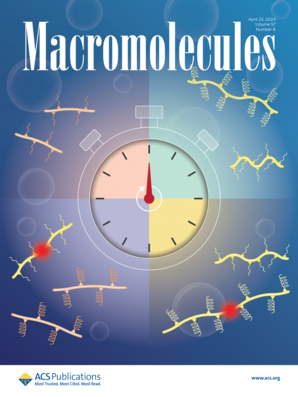纳米压痕共轭聚合物弹性模量的基准测试
IF 5.1
1区 化学
Q1 POLYMER SCIENCE
引用次数: 0
摘要
弹性模量是设计用于可穿戴电子产品的共轭聚合物的关键参数,它与电和热输运有关。然而,由于加工和测量条件的影响,包括变形的温度、模态、方向和时间尺度,对于同一材料,已经报道了广泛不同的值。因此,通过不同方法得到的结果通常不被认为具有可比性。在这里,从纳米压痕到独立薄膜或薄膜在水中的拉伸测试、屈曲分析、动态机械热分析、振荡剪切流变学和原子力显微镜等不同的技术进行了比较。引人注目的是,同一批次区域规则聚(3-己基噻吩)的弹性模量值相差不到4倍,这表明近似比较是可能的。考虑到通常可用的材料很少,纳米压痕结合蠕变分析被认为是一种可靠的方法,可以探测薄膜的弹性模量,弹性模量差异很大,从具有聚醚侧链的聚噻吩的小于0.1 GPa到没有侧链的聚合物的几个GPa。由于薄膜可以显示各向异性弹性模量值,因此建议纳米压痕与平面内技术(如拉伸测试)相辅相成,以确保使用不同的变形模式进行完整的表征。本文章由计算机程序翻译,如有差异,请以英文原文为准。

Benchmarking the Elastic Modulus of Conjugated Polymers with Nanoindentation
The elastic modulus is a critical parameter for the design of conjugated polymers for wearable electronics and correlates with electrical and thermal transport. Yet, widely different values have been reported for the same material because of the influence of processing and measurement conditions, including the temperature, mode, direction, and time scale of deformation. Thus, results obtained via different methods are usually not considered to be comparable. Here, disparate techniques from nanoindentation to tensile testing of free-standing films or films on water, buckling analysis, dynamic mechanical thermal analysis, oscillatory shear rheometry, and atomic force microscopy are compared. Strikingly, elastic modulus values obtained for the same batch of regioregular poly(3-hexylthiophene) differ by a factor of less than four, which suggests that an approximate comparison is possible. Considering the small amount of material that is typically available, nanoindentation in combination with creep analysis is identified as a reliable method for probing the elastic modulus of films with widely different elastic moduli ranging from less than 0.1 GPa in the case of a polythiophene with oligoether side chains to several GPa for polymers without side chains. Since films can display anisotropic elastic modulus values, it is proposed that nanoindentation is complemented with an in-plane technique such as tensile testing to ensure a full characterization using different modes of deformation.
求助全文
通过发布文献求助,成功后即可免费获取论文全文。
去求助
来源期刊

Macromolecules
工程技术-高分子科学
CiteScore
9.30
自引率
16.40%
发文量
942
审稿时长
2 months
期刊介绍:
Macromolecules publishes original, fundamental, and impactful research on all aspects of polymer science. Topics of interest include synthesis (e.g., controlled polymerizations, polymerization catalysis, post polymerization modification, new monomer structures and polymer architectures, and polymerization mechanisms/kinetics analysis); phase behavior, thermodynamics, dynamic, and ordering/disordering phenomena (e.g., self-assembly, gelation, crystallization, solution/melt/solid-state characteristics); structure and properties (e.g., mechanical and rheological properties, surface/interfacial characteristics, electronic and transport properties); new state of the art characterization (e.g., spectroscopy, scattering, microscopy, rheology), simulation (e.g., Monte Carlo, molecular dynamics, multi-scale/coarse-grained modeling), and theoretical methods. Renewable/sustainable polymers, polymer networks, responsive polymers, electro-, magneto- and opto-active macromolecules, inorganic polymers, charge-transporting polymers (ion-containing, semiconducting, and conducting), nanostructured polymers, and polymer composites are also of interest. Typical papers published in Macromolecules showcase important and innovative concepts, experimental methods/observations, and theoretical/computational approaches that demonstrate a fundamental advance in the understanding of polymers.
 求助内容:
求助内容: 应助结果提醒方式:
应助结果提醒方式:


